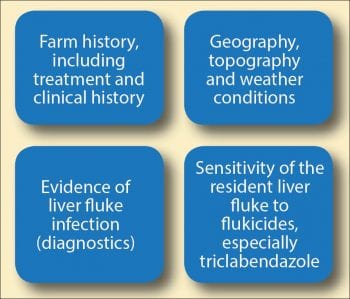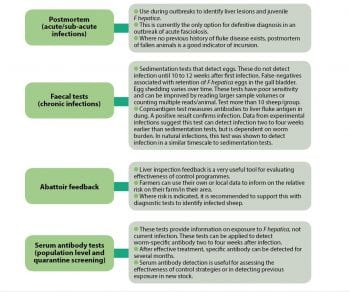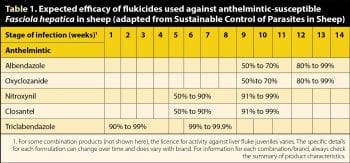5 Nov 2018
Jacqueline Matthews discusses the spread of this parasitic disease and methods of managing the spread of <em>Fasciola hepatica</em> on farms.

Liver fluke is an important parasite. The causative agent, Fasciola hepatica, has a wide host range, but is of particular importance in UK sheep because its prevalence is increasing and infection can result in a range of syndromes: from acute disease with sudden death to chronic disease and production loss.
Data available for the UK industry indicates losses of between £3 and £8 per head are not uncommon.
F hepatica has an indirect life cycle (Figure 1), including a period of development in a mud snail intermediate host, Galba truncatula. The life cycle of the parasite is driven by the habitat needs of the snail, such as a wet environment with slightly acidic soil. Because mud snails develop when average daily temperatures are above 10°C in high moisture, fasciolosis is recognised as a seasonal disease, traditionally encountered in autumn and winter.
Wet summers (in particular, high rainfall in May, June and July) increase the risk of outbreaks of acute or subacute fasciolosis because these conditions lead to more mud snails on pasture with a higher deposition of cercariae. If wet weather conditions persist, mud snails can release huge numbers of cercariae on to pasture in late summer/early autumn. As the incidence of acute or subacute fasciolosis depends on metacercarial uptake, higher contamination of pasture in late summer will increase the risk.
In very wet years, acute outbreaks can occur in late summer. In these cases, an outbreak may first present with sudden deaths due to the damage and haemorrhage caused by thousands of fluke larvae migrating in the liver; the case fatality rate in such outbreaks can be as high as 10%. Other sheep in these outbreaks may present with lethargy, dyspnoea and a reluctance to move.
At lower levels of infection (such as 500 to 1,000 metacercariae ingested), sheep present with anorexia, sudden weight loss, submandibular oedema, ascites, anaemia and poor fleece quality. Such outbreaks are usually reported in late autumn and winter. Most commonly, sheep present with chronic fasciolosis related to a lower level of ingestion of metacercariae (more than 200) over a longer period.

Chronic disease is most likely encountered from January to April. Here, sheep lose weight over time, with a poor condition score and fleece quality. Some sheep present with submandibular oedema, ascites and/or diarrhoea, and concurrent conditions (such as nematode infections, foot rot and Johne’s disease) may exacerbate the effect of chronic fasciolosis, so some sheep die.
Changes in weather patterns and a general increase in the prevalence of infection in cattle and sheep have led to fasciolosis being less seasonally restricted in the UK. Key to the survival/amplification of mud snails and the development of non-parasitic stages is precipitation between May and October.
In the past decade, fasciolosis has become more prevalent in the UK, with reports of infection or disease increasing geographically from the wetter western regions to the drier eastern areas. Why has this happened? It is thought a combination of climate change (resulting in milder winters and wetter summers) and high levels of sheep movements across the country have favoured transmission of F hepatica, increasing its regional reach. Moreover, resistance to the commonly used and broad-spectrum anthelmintic, triclabendazole, have made the disease more difficult to control at farm level.
This year has been rather unique; with a dry spring and summer in most regions, environmental conditions have been less favourable for snail development and F hepatica translation on to pasture. This should result in lower contamination in autumn and winter, reducing disease risk – particularly for acute fasciolosis, as sheep are less likely to be exposed to a substantial metacercarial challenge. However, reports of F hepatica infections were logged by abattoirs and diagnostic laboratories in September 2018 (https://bit.ly/2D0Bpam).
Mud snails are environmentally resistant, and can persist and multiply in wet or moist micro-environments such as around water troughs. Sheep will congregate in these areas when conditions are dry and hot. Similarly, on farms with permanently wet areas or land encompassing water bodies, mud snails continue to develop and multiply in hot weather.
In the UK, weather patterns vary tremendously across regions. For example, if one compares UK Met Office statistics for the west of Scotland for August 2018, where rainfall was recorded as 146.6mm, to the midlands, where rainfall was recorded as 55.4mm (https://bit.ly/2q4mQdg), it can be seen how factors affect the risk of disease vary substantially.
Fluke forecasting, based on meteorological data, is used to calculate risk of fasciolosis in the UK. Forecasts are generated by the National Animal Disease Information Service (NADIS), which divides the UK into different regions, providing a general prediction region by region. Each year, NADIS publishes a preliminary forecast in July, taking account of precipitation and temperature data from the preceding August to October and May to June periods.
In 2018, the forecast predicted moderate-high risk of fluke in north and west Scotland, and low risk in other regions (www.nadis.org.uk/parasite-forecast).
An update, based on rainfall and temperature data from the preceding May to October, was published in October and can be invaluable in assessing fasciolosis risk in 2018-19, as the amount of rain that falls in early autumn will have a key impact on the level of infection on pasture.

As indicated, fasciolosis is becoming less easy to predict purely by season alone and the parasite is becoming increasingly challenging to control. Environmental stewardship schemes that farmers are encouraged to participate in can complicate control plans because drainage of waterlogged land is discouraged, which may preserve or even expand mud snail-friendly habitats.
Another confounding issue is liver fluke resistance to triclabendazole. This is the only anthelmintic that kills early stage F hepatica, and is an essential tool in the prevention and treatment of acute disease. Low efficacy of triclabendazole has been reported in the UK for many years; however, mechanisms underlying its lack of effect have been difficult to pin-point. This is because of limitations in the diagnostic tests available to detect triclabendazole resistance and the difficulty in separating true resistance from the effects of other factors such as ineffective anthelmintic application, overwhelming metacercarial challenge (which can result in immediate reinfection after dosing) and, in diseased sheep, liver damage that affects the pharmacokinetics of the compound.
Aspects to consider when designing a control plan are summarised in Figure 2.
A key component of control programmes is to adapt farm management procedures to eliminate access of sheep to mud snail-friendly environments; for example, by fencing off wet areas from grazing access and/or improving drainage in an attempt to dry the environment. Cattle are also susceptible to liver fluke, so pastures previously grazed by them must also be considered as a potential risk for infection.
Because of the need to preserve anthelmintic efficacy, diagnostic tests should be employed to inform the need for flukicide treatment at certain times of year. Diagnostics available for detecting infection are summarised in Figure 3. The tests will be particularly useful in 2018 to assess if transmission of fluke to animals has occurred despite the preceding hot, dry summer.

Flukicides have a varying spectra of activity against different developmental stages of F hepatica in the host (Table 1). It is vital to select the most appropriate flukicide for the F hepatica stages that need targeting by treatment to protect efficacy of triclabendazole.
As indicated, treatment of acute fasciolosis requires a compound active against young juvenile flukes; only triclabendazole has activity against these stages (in drug-sensitive populations) and triclabendazole-containing products should be reserved for sheep where a risk of acute or subacute fasciolosis or during an outbreak of acute fasciolosis exists. Closantel, nitroxynil, oxyclosanide and albendazole should be used for the treatment of chronic fasciolosis.
In acute fasciolosis outbreaks, all sheep should be treated then moved to lower risk pasture (if available), as triclabendazole does not have a persistent effect against reinfection. If clean grazing is not available, a second treatment with triclabendazole will be required three weeks later, but animals can die after treatment. In subacute outbreaks, an anthelmintic with activity against later immature fluke (nitroxynil and closantel) should be administered.
Again, sheep need to be moved to lower risk areas after treatment as these flukicides do not have a persistent effect against incoming parasites. If sheep cannot be moved, a second treatment should be administered (five to eight weeks). In outbreaks of chronic fasciolosis, flukicides with a narrow spectrum against adult parasites should be administered and the sheep moved to lower risk pastures after treatment.
Narrow spectrum compounds that target adult fluke stages are valuable in control programmes for reducing egg shedding into the environment to break the transmission cycle; for example, in the treatment of ewes in spring – ideally, after using a diagnostic test (FEC or coproantigen test) that informs the need to treat.
Combination anthelmintics (such as products that contain anti-nematode and anti-fluke compounds) are not recommended because the parasites or stages targeted by the anthelmintics do not usually coincide. If used in autumn or winter, such products will apply unnecessary selection pressure for anthelmintic resistance in the parasitic nematode species.
Triclabendazole resistance is a major threat to the control and treatment of acute fasciolosis, and, on farms where liver fluke is identified as an issue, it is of value to establish sensitivity of the resident worm population to this flukicide. Unlike for nematode infections, field-based methods for detection of flukicide resistance in sheep are not well validated.
Resistance is often first suspected where triclabendazole has failed to kill immature worms that develop to adults after treatment with fluke eggs detected earlier than would be anticipated in drug-sensitive populations. Methods to test conclusively for flukicide resistance are still in development; Table 2 provides a summary of the recommendations for these.
Where resistance to triclabendazole is identified, this provides a serious challenge and management measures need to be used to address the threat of an acute outbreak. These measures include grazing sheep on the lowest risk fields in late summer and early autumn, fencing off areas where metacercarial challenge is likely to be high and/or housing sheep when likely to be most at risk of infection.
An alternative class of anthelmintic can be used to treat disease, as well as lower farm infection levels, keeping in mind all non-triclabendazole compounds have a lower spectrum of activity against early stage fluke.
For new stock originating from an area where F hepatica is endemic, flukicide administration at entry should be considered if the recipient farm contains environments that potentially support the survival of mud snails.
Products that do not contain triclabendazole should be used at quarantine (such as closantel and nitroxynil), keeping in mind these will not kill larvae, so a second treatment will be required six weeks later. Incoming sheep should be withheld from grazing with resident sheep, or grazed on dry well-drained pastures unlikely to host mud snails, until at least four weeks after the first treatment.